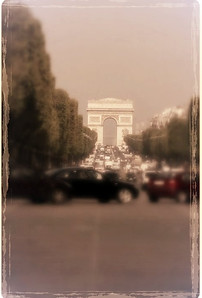
A symbol of French patriotism, it is the setting for military parades, various celebrations and events.
From its panoramic terrace - it is worth climbing the nearly three hundred steps - you can admire the twelve avenues that surround Charles de Gaulle square, including one of the most famous in the world, the Champs Elysee, which is well worth a visit. The avenues and the square form a star; Parisians refer to it as “place Étoile”, its former name. The 360 degree view is impressive.



Do not try to cross the street. An underground pedestrian walkway leads to the base of the arch.
If you bought the Paris Museum Pass , the entrance is already included, just show the inspector at the concierge. There are sites that sell them over the internet, but despite the queue at the window sometimes being long, ticket sales are usually very fast.

Names of battles and generals are engraved on its walls, as well as several sculptures, and at its base is the Tomb of the Unknown Soldier of World War I that honors all soldiers killed in combat - its flame is lit daily at 6:30 pm.
Paris - Champs Elysées Timelapse (full HD) - (01:08) - ToutParisEnVideo
Even if it's just to go around Place Charles de Gaulle and photograph the monument, anyone who goes to Paris (at least for the first time) can't help but admire this one of the most famous monuments in the city.
What Napoleon did not know was that the building would only be completed 30 years later, that is, 15 years after his death. But he was still honored: his remains were brought from the island of Saint Helena, where he died, and passed under his Grand Arch in 1840 on their way to his grave at the Hôtel National des Invalides.
The Battle of Austerlitz (1805), which resulted in one of Napoleon Bonaparte's greatest triumphs, would have motivated the construction of the Arch. History has it that, on the battlefield, Napoleon assured the soldiers: “You will return under triumphal arches”.
Well, after choosing the best location for the construction, the work began in 1806. It was designed by the architect Jean Chalgrin, inspired by the “Arch of Titus”, a Roman triumphal arch.

Arc de Triomphe seen from Place de la Concorde, having, left, detail of Luxor Obelisk.
The arch can be seen from several places in the city, in view of the ban on the construction of tall buildings in that surroundings.
Up the stairs, a small museum displays Napoleon's objects and tells the story of the arch's construction.
From the top, you can see, in the distance, the modern “Arche de la Defense”, opened in 1989 - which celebrates the glories of humanity, in a business district, with tall buildings. The arch marks the end of a historic axis that runs from the Louvre, through the Champs Élysées and reaches La Defense.
Don't miss the Avenue des Champs Élysées. Famous shops and their impeccable shop windows, art galleries, cafes and restaurants make for a great walk, even more so if you follow and go to the Grand Palais area, where a beautiful green area and several benches for a rest are a delight for our guests. eyes and little feet, by now a little tired.
Click on the word Google on the map to view the area and plot your route
Drag the doll on the map to the red balloon to visit the place


ARC DE TRIOMPHE
print !
Write down !
Place Charles de Gaulle - 75008 Paris
Metro: lines 1, 2 and 6 (Charles-de-Gaulle-Etoile)
RER Charles-de-Gaulle-Etoile station
April to September: 10 am to 11 pm. October to March: 10 am to 10:30 pm.
The box office closes ticket sales half an hour before.
Closed
January 1
May 1 and 8 (in the morning)
July 14 (in the morning)
November 11 (in the morning)
December 25
Click on a tourist spot to know more...
